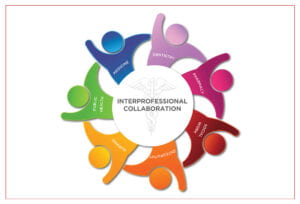
By Rick Valachovic, DMD, MPH, Clinical Professor and Director of the NYU Dentistry Center for Oral Health Policy and Management
Last month I traveled to Washington, DC for the celebration of a colleague and a dear friend. No, she’s not a dentist. She’s a pharmacist. And our dinner companions were physicians, social workers, public health professionals, nurses, and clinicians of other stripes. Many of us had known each other for many years, and in 2007, a core group of us banded together around a common purpose: educating our health professions students for interprofessional practice.
“We had this vision that people should collaborate in practice,” Polly Bednash, PhD, RN, FAAN, recalled when we recently spoke. “The Joint Commission was very clear in its work on patient safety. Almost uniformly, communication problems were what caused errors, and we agreed that we have to figure out how people can talk to each other and trust each other and respect each other’s work and see their work as having value to the whole enterprise.”
At the time, Polly, who currently serves on the Board of Trustees of Dartmouth Health and several other health entities, was leading the American Association of Colleges of Nursing. She, Carol Aschenbrenner, MD (then chief medical education officer at the Association of American Medical Colleges), our counterparts at the American Association of Colleges of Osteopathic Medicine, the American Association of Colleges of Pharmacy, and the Association of Schools and Programs of Public Health, and I (then President and CEO of the American Dental Education Association) would meet every few weeks to wrestle with what it would take to bring our learners together. Along the way, we started to share stories about our professional challenges and personal lives. These comfortable exchanges created an environment for engaging in substantive, frank discussion around interprofessional education (IPE) as well.
By 2009, we had formed the Interprofessional Education Collaborative (IPEC), the group that hosted the celebration dinner I mentioned. The guest of honor was its immediate past chair, Lucinda Maine, PhD, RPh. Having worked closely with Lucinda and the other IPEC founders, this was an event I was not about to miss, and they felt the same about the special bond we had formed, one that transcended other professional relationships.
As Polly put it, “I don’t think this could ever have happened if we hadn’t started to develop personal relationships. We began to actually trust that we were not looking to stake out territory for each profession. Instead, we were driving toward a common goal—the greater good of the people we were supposed to serve as health professionals.”
Today, IPEC is alive and well, and it currently boasts 21 national associations representing various health professions as members. The Core Competencies for Interprofessional Collaborative Practice, which IPEC developed in 2011, have been widely embraced, and in recent years, more universities have established offices and created administrative roles to facilitate IPE on their campuses, thanks in part to IPEC’s influence.
Last month, the organization hosted its fifth annual IPEC Interprofessional Leadership Development Program, a three-day professional development experience facilitated by the Academy for Advancing Leadership (AAL). The theme of this year’s IPEC gathering was bridging the gaps between education and practice.
Unfortunately, those gaps still persist, and can be especially challenging at health professions institutions housed outside of academic health centers. As Karl Haden, PhD, who leads AAL, put it, “Much of education is isolated from practice, and health professions are still largely siloed. The physical and geographic distance between the institutions and their partners is another fundamental challenge.”
Karl acknowledged that some institutions are working hard to create more authentic interprofessional clinical experiences for their students. Making these universally available is going to involve more conversations with the practice community, health systems, and possibly the organized professions, in his view. “That means building bridges to the practice community that haven’t been there before,” he told me.
The NYU College of Dentistry is fortunate to be part of an academic health center and to have had leadership supporting IPE since the days when Michael Alfano, DMD, PhD, was dean. Under Mike’s leadership, NYU’s nursing programs, which were housed at the time in the NYU School of Education, found a new home in a college of nursing housed within the College of Dentistry. The novel arrangement made NYU a pioneer in interprofessional collaboration and fostered the development of many nurse leaders with strong commitments to integrating oral health into overall health care.
The best known of these is Judith Haber, APRN-BC, PhD, FAAN, Ursula Springer Leadership Professor in Nursing at NYU Rory Meyers College of Nursing. Judi took the lead in forming the Oral Health Nursing Education and Practice program, a national initiative aimed at integrating oral health into nursing care and education. She was also the lead author on an influential paper, Putting the Mouth Back in the Head: HEENT to HEENOT, which advocated that all health professionals routinely look inside the mouth when assessing a patient’s eyes, ears, nose, and throat. While not universally employed, the HEENOT exam has been widely disseminated.
When I last spoke with Judi about the early days of IPE, she described oral health as “the key that turned the lock” when NYU faculty were thinking about innovative strategies for meeting accreditation standards related to IPE. “Oral health was a perfect clinical education focus for operationalizing the IPEC competencies in nursing curricula,” she said.
I agree, and patients will benefit. That said, IPE is a two-way street, and even here at NYU, dental students remain relatively separate from their clinical peers in other health professions, just as dentists often do in practice. One positive development is the recent addition of a federally qualified health center (FQHC), Metro Community Health Centers, to the NYU Dentistry clinics. The common location gives dental and dental hygiene students opportunities to collaborate with medical professionals in primary care and behavioral health and to learn how to advocate for patients’ overall health.
Is that enough? Absolutely not. “In our IPEC panel discussions, the disconnect between the education and the practice communities was clear,” Karl told me. “Many practitioners (and health systems) are unaware of IPE efforts. In addition, many educators do not appreciate the challenges graduates face when they enter the practice setting. I think of IPE as a strategy with a vision for how practice should be; in the practice setting, this strategy is often derailed by organizational culture and the imperative for fiscal responsibility and generation of revenue.”
The good news is that students who do take part in authentic interprofessional experiences love them. “It makes them feel like they’re part of something larger than themselves and who they are as a particular discipline,” Polly told me, “and if you can get students exposed to these kinds of collaborative experiences, they will demand more of them.”
That’s what I’ve seen as well. When NYU Dentistry Dean Charles Bertolami, DDS, DMedSc, and I gave a detailed presentation on interprofessional education and clinical practice to NYU’s third year dental students in April, they were excited by the potential of collaborative care to transform dental practice and patients’ lives.
I hope that enthusiasm carries over into classrooms and clinics. IPEC laid a solid foundation for IPE, but over the years, the work of constructing education and practice environments that foster collaboration has become sporadic. In my view, it’s past time to renew our focus on IPE. Dental educators can start by acquainting themselves with a paper I wrote for the Journal of Dental Education on integrating oral and overall health care in this 2021 paper in Frontiers in Oral Health. The authors mine the wisdom contained in three leading integrated practices to propose recommendations for reshaping dental education. I’m also looking forward to reading the results of IPEC’s recently completed scoping review, which provides strong evidence that IPE impacts patient outcomes. The evidence is on our side. Now we need to recommit to doing the hard work of preparing our students for interprofessional collaborative practice.

It’s great to see that this work continues with exceptional leadership from individuals such as yourself. Thank you for sharing this information.